As I told you in my wet blocking tutorial, children’s play mats make an inexpensive and easy to find alternative to dedicated blocking mats. BUT, I’ve discovered a problem that you need to know about if you use these mats – please read this and learn from my experience!
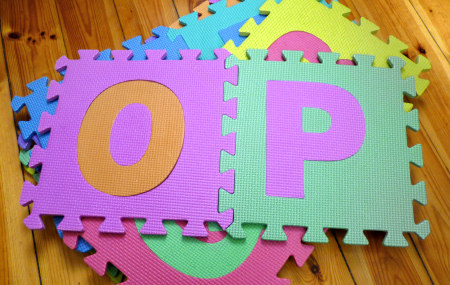
I’ve blocked all kinds of lace with these mats before with no problems, but my crocheted bamboo cardigan was a different story. My laceweight items felt practically dry by the time I pinned them to the mats, but thicker yarn retains much more moisture, so, even after rolling my cardigan in a towel to squeeze out as much excess moisture as possible, it still felt heavy and noticeably damp to the touch. It was still damp 24 hours later, and when I flipped it over so the underside could dry better, I was horrified to find areas of my beautiful cream cardigan were now bright, shocking pink.
I don’t have a photo, as my priority was trying to fix the disaster, not documenting it. Luckily, my story ended well; I’m not sure if it was because the yarn was still damp when I spotted the problem, or if the pink dye isn’t permanent, but after a few soaks in Soak wash, with some delicate but persistent agitation by hand in the sink, all the pink colour came out of my cardigan (phew). But you don’t want to take a chance that your mats may permanently dye your handiwork!
Looking back, I should have suspected that there may be a problem with colour transfer from the pink blocks – if you look at this photo from my blocking tutorial, you can see that some of the bright pink colour from a different mat has transferred onto the lower yellow block, at the right-hand side:
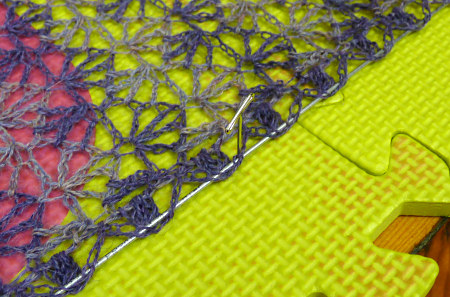
My cream cardigan also had this pink colour transfer before I managed to soak it all out!
Foam Mat Colour Transfer Experiment
Although I assumed this colour came from the bright pink coloured blocks – the same colour as the pink stain – to be safe, I decided to conduct an experiment to figure out which of the blocks are the culprits. (I’m very glad I did, because the results surprised me!)
Method
- Select enough blocks to have a sample of each foam colour: orange, yellow, green, blue-green, blue, purple, light pink, dark pink. (I also tested a solid purple mat I bought from a different source.)
- Lay a piece of paper kitchen towel over each colour of foam. Spray all the blocks with water until the paper towel squares are completely saturated.
- Leave overnight to dry.
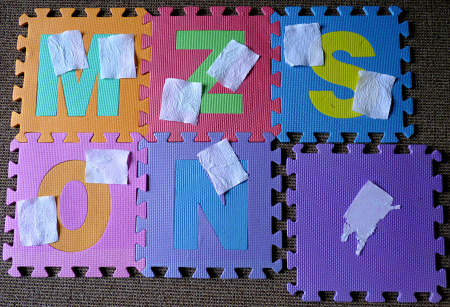
The setup for my experiment – wet paper towel squares on a sample of every foam colour
When the paper towel was completely dry, I numbered each piece as I removed it, so I could compare them with my reference layout photo (top row L-R: samples 1-6; bottom row L-R: samples 7-10).
Results
- Samples 1 and 2 (orange and blue-green) were clear.
- Samples 3 and 4 (dark pink and green) were stained in only the dark pink areas.
- Samples 5 and 6 (blue and yellow) were clear.
- Samples 7 and 8 (light pink and orange) were stained in only the light pink areas.
- Sample 9 (purple and blue) was stained in only the purple areas.
- Sample 10 (all purple) was stained all over.
Example of my results:
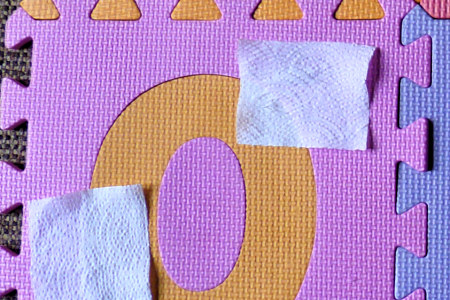
Sample 8 (top right in this photo) is mostly over the light pink foam, except the lower left corner which is over the orange O.
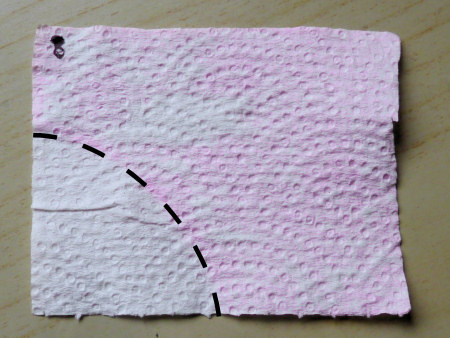
Sample 8 clearly shows that colour has transferred from the background pink foam, but not from the orange O (dotted line added for clarity).
Conclusions
My samples clearly show that pink dye leaches out of light pink, dark pink, and purple foam when wet. The colour transfer seems to be equal between all these colours. All the other foam colours (orange, yellow, green, blue-green, and blue) appear to be colour-fast when wet.
This surprised me – I thought that only dark pink would be the problem, and possibly the light pink. I never even considered that purple foam might also leave pink stains, and equally badly as the over-saturated bright pink blocks! Note: My set didn’t include any red blocks, but I suspect they would suffer from the same problem. UPDATE: see the end of this post.
My Recommendations
If you haven’t bought foam mats yet, you may prefer to look for some that avoid the problem pinks and purples (and, probably, reds). I’ve seen all-grey sets sold as utility mats, and individual coloured blocks sold at dollar stores. Grey, blue, green, yellow and orange should all be safe.
If you already own foam mats, I’d recommend that you replicate my simple kitchen towel experiment – it’s easy to do, and then you’ll know for sure, one way or the other. If you do have the problem, you have some options to get around it:
Prevention Option 1: Only use the blocks with ‘safe’ colours that do not contain pink (safe: orange, yellow, blue, blue-green, green). Do not use light pink, dark pink or purple. Note: If your mats are different colours or types, test them to see which of your colours are affected.
Prevention Option 2: Lay out an old towel over your blocks, so any colour will transfer to the towel, not your precious handiwork. You can pin straight through the towel and into the foam.
If there was any colour transfer when I blocked this cardigan (below), it doesn’t show against the dark grey yarn. Look at all the blocks that could have stained my yarn pink!
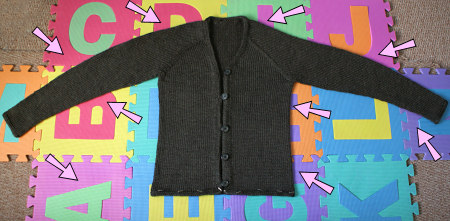
Arrows mark ‘dangerous’ colours: light pink, dark pink, and purple.
Below, you can see the second blocking for my miraculously-unscathed bamboo cardigan – now safely protected from any pink transfer by the towel. The underside of the towel was stained pink after this, but it all came out in the wash. (And, in case you’re wondering, the plastic containers at the corners of the towel are filled with water – I used them as weights to stop the towel from blowing away while I dried the cardigan outside!)
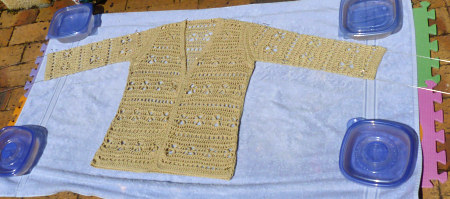
Cardigan protected from colour transfer by a towel on top of the foam mats.
If you’re blocking lightweight yarn and you roll it in a towel before blocking so it feels almost dry when you lay it out to block, you shouldn’t have a problem with colour transfer, but you may wish to err on the side of caution – my results may not always apply. For anything that still feels damp/heavy after a towel squeeze, you should definitely be careful of potential colour transfer, and I’d recommend you test your mats and/or use one of the prevention options above, especially if you’re using light-coloured yarn. Why take the risk?
UPDATE: Thanks to Andrea Giattini (@SpringSplndr) for this update! Andrea has a set of 8 of the larger 2ft square foam mats that come in red, yellow, green and blue, and are sold for use in garages, playrooms etc. She has been using them for 3 years and had never noticed any transfer.
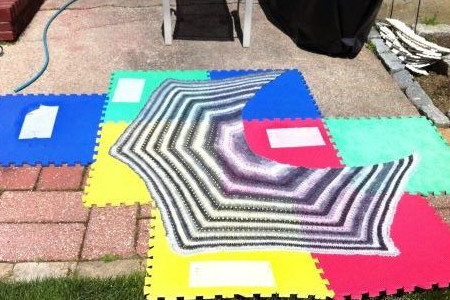
Photo courtesy of Andrea Giattini
Andrea kindly agreed to try my test on her mats. She saturated white paper towels with water and left them to dry in the sun, as you can see above. She reports no colour transfer from any of these mats (even the red one, which I was most concerned about).
It appears that these red/yellow/blue/green mats are more colourfast than the sets that include purples, pinks, etc, which can bleed pink dye. However, I still advise caution – different brands may use different dyes, and manufacturing processes may change with time, so, for your own peace of mind, I’d still suggest you try the test on your mats too, just to be safe.
















Linda said
This happened to me today!!!! With my daughters crocheted cotton/wool wedding dress!!!! I will try soaking it as you did. Thank you, June.
Caroline said
I’ve been looking at various options for blocking my first lace shawls.And today I went looking at kids foam blocks, very much like the ones you mention having.
So you can imagine my relief in reading your article ‘before’ purchasing them.
Thank you very much for all the information regarding possible dye transfer, it is very much appreciated!
Mary Beth Fromm said
Has anyone tried the 2′ X 2′ flooring squares from Home Depot? They are in pkgs of 4 in red, blue, yellow & green. Can’t tell if the backs are white from the pics and it IS 2 years later than your first warning! Please let me know. I can get the KnitPick 1′ X 1′ in solid gray or these from Home Depot. The colors are more fun, but not if they bleed onto my projects.
June said
Those sound like Andrea’s mats – read the update at the end of my post above for more details of her experience.
Kathy said
Hi everyone!
I stumbled across this site looking for ways to get the dye up. I had the bigger block mats (the ones your friend didn’t bleed) and no, they never bled on the top HOWEVER.. the bottom.. different story! the Red ones left stains on my FLOOR!! EEEP!! we figure some water spilled and no matter how much you “dry it” those foam mats seem to hold a little water on the bottom.. so we’ve got two big red blotches on the floor 🙁
hoping someone has an idea on how to get this color up? its like a lynolium flooring that looks like wood (had grooves and everything)
Janean said
Hi,
Thanks for the article. I just wanted to give you an answer as to why your pinks and purples were stained. Red dyes are impermanent. They fade faster in light and (as we all have experienced with the “pink sock syndrome”) in the wash. There is non such thing as a completely permanent red dye. That is why your pinks and purple, which contains red dye, were the culprits! I am a museum curator and we always avoid red in long term exhibit labels and are very cautious about putting artifacts with red on them on exhibit for long periods for the same reason!
Marilynn Williams said
I also use the colored blocks, but I use the back side, which is white. Is there a problem with using the reverse side?
Thanks,
Marilynn
June said
That’s great, Marilynn! You and C Shaffer (who commented the same thing yesterday) are fortunate to have a white-backed set and be able to avoid this problem by using the reverse side.
I haven’t seen any foam mats like that, but it’s good to know they exist (it’s another option for people to look out for when they’re shopping for foam mats). Were they sold as play mats?
Rene Bartlett said
I have A set of the playmats but they do not have any letters.My question is will the dye come out of them the same as the ones with letters?
June said
If yours contain the same dye and were processed in the same way, they’ll still bleed; I suggest you try my paper towel test so you’ll know for sure, one way or the other.
C shaffer said
I used my foam blocks upside down which is an all white side
Mary Lehner said
I have the same alphabet squares, and use a towel under whatever I’m blocking
because the smell of the mats is so chemically… I don’t want to block that into my projects!
Paulette Bergman said
Hi to all!
Would a flannel-backed tablecloth (inexpensive) work as the layer between the colored mats and the damp/wet item to be blocked? You would have the choice of having the flannel or vinyl side toward your item.
Good to know the problems and hints others have had before trying to reinvent the wheel.
Thank you!! pj
June said
That should work, Paulette, provided the tablecloth is colour-fast itself; a friend once blocked a white shawl on a green towel, and the green colour transferred to the shawl… You do need to be careful that any fabric you block onto is colour-fast (another reason why I suggested an old towel), so a white/cream tablecloth would be safer than a coloured one.
Sue Bent said
I use mats similar to these. Before I used them the first time I covered them with a very large clear plastic bag and then an old whit flat sheet. As a result I did not have a problem.
Gayle said
I would guess that the problem lies in the red dye additive that was used since the purple also bled. (Red and blue make purple) just a guess, but we all know that reds have a tendency to bleed. Nice post tho.
Martha Roseen said
I wonder if pre-washing/soaking these mats in a bleach solution would remove enough pigment to reduce transfer? Or would it degrade the mats?
June said
Interesting idea, Martha! I don’t know if it would work, but I’d love to find out. If anyone tries it, please post your results here…
Jana said
We had a group of Arizona Fish and Game people here at the camp last week. For some reason, they had dark grey mats like these and left a bunch of them in the cabins! Amber was going to throw them out but I stopped her. Today, after work, I laid some out on the floor and they are perfect! I have twelve of them and each one is about two feet square! I just need to clean and sanitize them, but I now have free blocking mats! And lucky for me, the color should be fine. 🙂
Chris said
The only things you need for blocking are rustproof pins and a sheet of foam core board. This is what professional framers use. An aunt who had a yarn shop in Boston also did this. As a seamstress who specialized in weddings I blocked 100s of pieces of lace items the same way. There is no danger of color or paper transfer. Use a rubber thimble to protect the finger pushing the pins. Give it a try and see how you like this method.
June said
Ooh, that’s a great idea, Chris – thanks! All my lace items are larger than one sheet of board, though – foam mats have the advantage that you can assemble them into the size and shape you need for each item.
I’m also wondering if foamcore may only be suitable for lace, not the heavier (wetter) items that have caused this colour transfer with my mats (sweaters, afghans, etc)… My reasoning is that the surface of foamcore board is paper-based, so I’m not sure what would happen if you left something wet on it for 24-48 hours. If anyone knows, please confirm if this is a problem or not!
Cherish said
Thank you for posting this! I was just looking at a set of these mats, as they’re MUCH less expensive than the white mats sold specifically for blocking.
June said
I’m not recommending against buying them, specifically, but you obviously have to factor this into your decision about whether it’s actually such a bargain! I’ll continue to use mine for blocking lace and, with the towel, for blocking anything else.
I’ve asked a friend who has the larger 2ft square mats that come in red, green, blue and yellow to replicate my test and see if the red transfers too. I’ll update this post when I have the results.
Chrisie said
Thanks for sharing! I think I have the same block set. I haven’t had any problems, but I will definitely take extra precautions from now on.
mari said
I love looking at all your items, and the thoroughness with which you post. I have to admit that I “look” more than I “do” but your handiwork is certainly inspirational! Thank you!
Briana said
Thank you for sharing this scary story!! I’m so glad to hear it had a happy ending 🙂
I never even thought of the color transfer issue, so I really appreciate this thorough blog post with the problem, ways to test to see if it will be a problem for us, and some simple solutions!
As always, I just love reading your blog 🙂 🙂